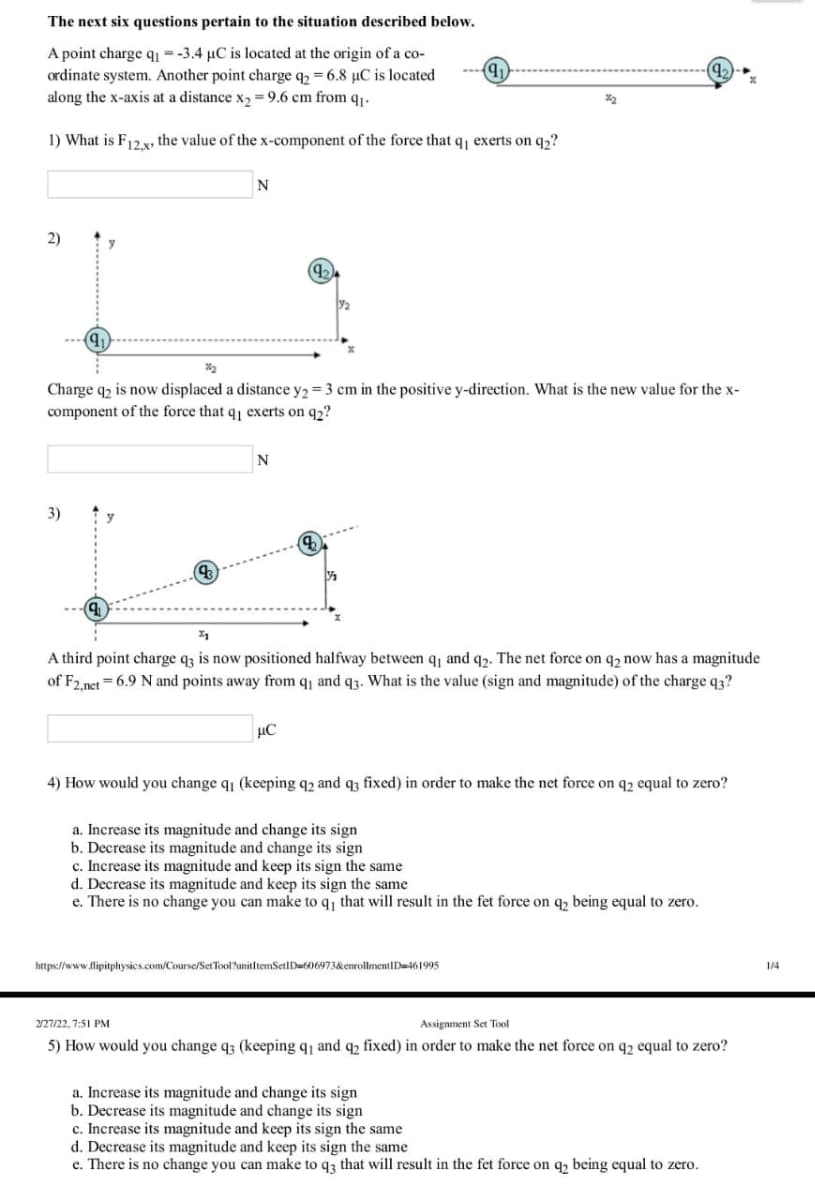The next six questions pertain to the situation described below. A point charge q --3.4 µC is located at the origin of a co- ordinate system. Another point charge q2 =6.8 µC is located along the x-axis at a distance x, = 9.6 cm from q1. 42 1) What is F12,x, the value of the x-component of the force that q, exerts on q2? N 2) 42 Charge q2 is now displaced a distance y, = 3 cm in the positive y-direction. What is the new value for the x- component of the force that q exerts on q2?
The next six questions pertain to the situation described below. A point charge q --3.4 µC is located at the origin of a co- ordinate system. Another point charge q2 =6.8 µC is located along the x-axis at a distance x, = 9.6 cm from q1. 42 1) What is F12,x, the value of the x-component of the force that q, exerts on q2? N 2) 42 Charge q2 is now displaced a distance y, = 3 cm in the positive y-direction. What is the new value for the x- component of the force that q exerts on q2?
College Physics
10th Edition
ISBN:9781285737027
Author:Raymond A. Serway, Chris Vuille
Publisher:Raymond A. Serway, Chris Vuille
Chapter15: Electric Forces And Electric Fields
Section: Chapter Questions
Problem 16P: Panicle A of charge 3.00 104 C is at the origin, particle B of charge 6.00 104 C is at (4.00 m,...
Related questions
Question
Needed to be solve correctly it's questions one all parts are related so please solve all and get the thumbs up thanks

Transcribed Image Text:The next six questions pertain to the situation described below.
A point charge q --3.4 µC is located at the origin of a co-
ordinate system. Another point charge q2 = 6.8 µC is located
along the x-axis at a distance x, = 9.6 cm from qı.
92
1) What is F12x, the value of the x-component of the force that q, exerts on q,?
N
2)
(9)
Charge q2 is now displaced a distance y2 =3 cm in the positive y-direction. What is the new value for the x-
component of the force that q exerts on q2?
3)
A third point charge q3 is now positioned halfway between q and q2. The net force on q2 now has a magnitude
91
of F2. net = 6.9 Nand points away from q and q3. What is the value (sign and magnitude) of the charge q3?
4) How would you change q1 (keeping q2 and q3 fixed) in order to make the net force on q2 equal to zero?
a. Increase its magnitude and change its sign
b. Decrease its magnitude and change its sign
c. Increase its magnitude and keep its sign the same
d. Decrease its magnitude and keep its sign the same
e. There is no change you can make to q, that will result in the fet force on q, being equal to zero.
https://www.flipitphysics.com/Course/SetTool?unitltemSetlD=606973&enrollmentID=461995
1/4
2/27/22, 7:51 PM
Assignment Set Tool
5) How would you change q3 (keeping q and q2 fixed) in order to make the net force on q2 equal to zero?
a. Increase its magnitude and change its sign
b. Decrease its magnitude and change its sign
c. Increase its magnitude and keep its sign the same
d. Decrease its magnitude and keep its sign the same
e. There is no change you can make to q3 that will result in the fet force on q, being equal to zero.
Expert Solution
This question has been solved!
Explore an expertly crafted, step-by-step solution for a thorough understanding of key concepts.
Step by step
Solved in 2 steps with 2 images

Knowledge Booster
Learn more about
Need a deep-dive on the concept behind this application? Look no further. Learn more about this topic, physics and related others by exploring similar questions and additional content below.Recommended textbooks for you

College Physics
Physics
ISBN:
9781285737027
Author:
Raymond A. Serway, Chris Vuille
Publisher:
Cengage Learning

Principles of Physics: A Calculus-Based Text
Physics
ISBN:
9781133104261
Author:
Raymond A. Serway, John W. Jewett
Publisher:
Cengage Learning

Physics for Scientists and Engineers, Technology …
Physics
ISBN:
9781305116399
Author:
Raymond A. Serway, John W. Jewett
Publisher:
Cengage Learning

College Physics
Physics
ISBN:
9781285737027
Author:
Raymond A. Serway, Chris Vuille
Publisher:
Cengage Learning

Principles of Physics: A Calculus-Based Text
Physics
ISBN:
9781133104261
Author:
Raymond A. Serway, John W. Jewett
Publisher:
Cengage Learning

Physics for Scientists and Engineers, Technology …
Physics
ISBN:
9781305116399
Author:
Raymond A. Serway, John W. Jewett
Publisher:
Cengage Learning

College Physics
Physics
ISBN:
9781305952300
Author:
Raymond A. Serway, Chris Vuille
Publisher:
Cengage Learning

Physics for Scientists and Engineers: Foundations…
Physics
ISBN:
9781133939146
Author:
Katz, Debora M.
Publisher:
Cengage Learning
